Agronomy Update
Jun 03, 2024
“On The Horizon” Podcast Series
 This last fall we created a new position at Horizon Resources of Marketing Director. We were excited to hire Jill Foust who has been with our team now since October. One of the many goals we gave Jill was to increase member engagement and hopefully bring back the magazine we used to send out entitled “On The Horizon.” Unfortunately print costs have, like everything else, risen drastically. Fortunately, in today’s day and age we have the luxury of technology and the ability to create and upload podcasts at virtually no expense to our member owners. I’d encourage you to join us on this journey as we invite guests from across the country to share their insights and vision for global agriculture and how it impacts the owners of Horizon Resources. Episode one features Dr. Frayne Olson who discusses market conditions for durum and canola, and most recently Horizon Resources CEO, Jeff Wagner and Agronomy Manager John Salvevold joined me on the show. Check out our episodes every Friday on Apple Podcasts, Spotify, and YouTube!
This last fall we created a new position at Horizon Resources of Marketing Director. We were excited to hire Jill Foust who has been with our team now since October. One of the many goals we gave Jill was to increase member engagement and hopefully bring back the magazine we used to send out entitled “On The Horizon.” Unfortunately print costs have, like everything else, risen drastically. Fortunately, in today’s day and age we have the luxury of technology and the ability to create and upload podcasts at virtually no expense to our member owners. I’d encourage you to join us on this journey as we invite guests from across the country to share their insights and vision for global agriculture and how it impacts the owners of Horizon Resources. Episode one features Dr. Frayne Olson who discusses market conditions for durum and canola, and most recently Horizon Resources CEO, Jeff Wagner and Agronomy Manager John Salvevold joined me on the show. Check out our episodes every Friday on Apple Podcasts, Spotify, and YouTube! Levi Hall, COO/Grain Division Manager
Horizon Resources' Most Unwanted:
Lance-leaf sage (Salvia reflexa) — also known as, Mintweed, Lamb’s-leaf sage, Rocky Mountain sage, Sage mint, or Blue sage (Mint Family) Native to North American and found throughout the U.S., this weed tops out at about 2 feet tall, attaining a multi-stemmed, bushy stature. The stems branch opposite each other at an upward angle. The narrow, lance-shaped leaves are arranged opposite each other on short stems. Asymmetrical blue flowers grow on spikes in whorls of two or three. The flowering period is from June through early fall. According to Missouri State University, Lance-leaf sage has demonstrated resistance to multiple herbicide modes of action. This spring I found this weed in fields east and west of Williston. We need to pay attention to this weed as it can take over if left unchecked. As you can see in the pictures below, one plant is capable of producing many seeds. Sara Erickson, Agronomist
|
Seedling
 |
Flowering Plant
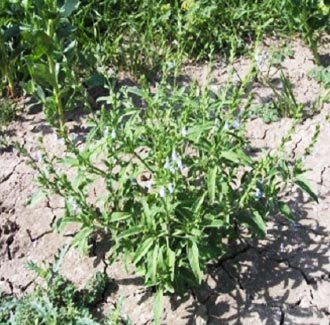 |
|
Mature Plant
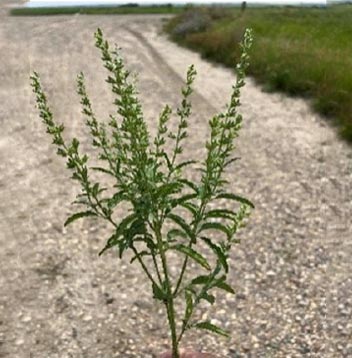 |
Flower with Seeds
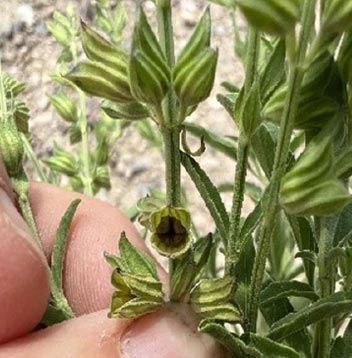 |
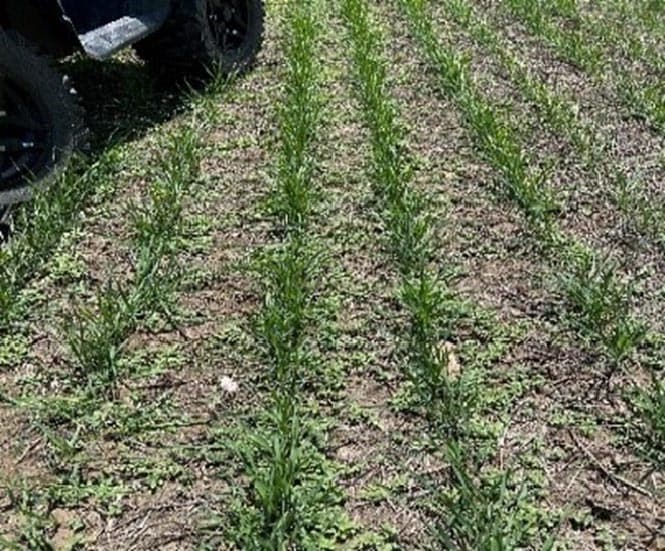 Durum field with a patch of small lance-leaf sage. This is the first time finding this weed in this field since I have started scouting it two years ago.
Durum field with a patch of small lance-leaf sage. This is the first time finding this weed in this field since I have started scouting it two years ago.
In Crop Spray Season is Here
Depending on your planting date, canola, durum and spring wheat are nearing or at the critical growth stages for in crop weed management. In the table below are predicted growth stages based on growing degree days for canola and wheat planted in April and May. Many herbicides need to be sprayed on wheat or durum at or before the 5 leaf stage so make sure you know what stage your crop is and what stage the herbicide you are spraying is recommended for. Regardless, you need to kill weeds when they are small (less than 4 inches) and weeds now are growing rapidly. Trying to kill a weed that is 8-10 inches tall is a rescue treatment and if you do not kill those weeds they will be even more tolerant to the herbicide used. | Planting Date | Growth Stage: Canola | Growth Stage: Wheat |
|---|---|---|
| 4/22 | Rosette - 4th leaf | 5 leaf |
| 4/29 | Rosette - 4th leaf | 4 leaf |
| 5/6 | Rosette - 4th leaf | 3 leaf |
| 5/13 | Rosette - 3rd leaf | 2 leaf |
| 5/20 | Seedling | 1 leaf |
Timing is Key for Weed Control in Canola
Seeding is wrapping up and now we are gearing up for in-crop weed control. For both glyphosate tolerant and Liberty Link canola varieties, you will be able to spray an in-crop herbicide application twice. The most important thing is to make sure you time the applications properly to maximize weed control. Your first application should be right when you can see the rows of the canola plants in the field. With the help of frequent rains, we are seeing rows form in canola fields which means now is the perfect time for your first herbicide application. Your second application needs to be applied before the canola plant begins to bolt. The goal is to spray the weeds when they are small enough that you can get good coverage and then they will be outcompeted by the canola when it gets to flowering.If your canola variety is glyphosate tolerant (Roundup Ready), it is more than likely a newer Truflexx variety. In these varieties you can apply up to 44 oz./ac of glyphosate per season, which can be split into two 22 oz./ac applications. If you plan to make only one pass, apply 32 oz./ac and you can delay that application slightly beyond row formation but don’t wait too long. With the rain and heat, the canola will start to bolt sooner rather than later and then you’re too late. We always add an AMS such as Class Act at 1gal/100 to prevent the glyphosate from being tied up with minerals in your water, and going with 5-10GPA will give you coverage on most weeds.
If you have a Glufosinate tolerate (Liberty Link) variety, you can make two passes at 22-29 oz./acre. With a Glufosinate herbicide, we want applications to occur on a hot sunny day. Glufosinate is not a strong chemical when it is cool and cloudy. It needs to have 70°F plus temperatures and sunny conditions to be effective. Along with the Glufosinate you need to add in a Group 1 grass herbicide like Section Three or Select into the mix. Liberty is a great chemical but it will only work on broadleaf weeds. Adding a clethodim product into the mix will help with the grass control. Adding in 2.5 lb./ac or 2.5 gal/100-gal H2O of AMS will keep the solution mixed and stable. Finally the most important thing to remember with spraying any Glufosinate product you have to go at a minimum of 15 GPA of water! 15-20 GPA is recommended and the more water the better. Glufosinate will work when it has the heat, sun, and water to get the best coverage there is.
If you have thick patches of Canada thistle in your crop or along the edges, add 2.4 oz./ac of Stinger HL into these mixes well. Just be aware of your rotation back to a pulse the following year as Stinger does have a rotation restriction. As always we are here to help you knock the weeds down and to get the cleanest field you can. If you have any questions feel free to reach out to our team.
Austin Semenko, Williston Agronomy Location Manager
Fungicide Decisions in Spring Wheat and Durum
Symptoms of Tan spot have been identified in durum fields, and weather conditions are conducive to the development of this and other foliar fungal diseases of durum and spring wheat. Yield response to early season fungicide depends on several factors including environment, previous crop, varietal susceptibility, tillage and the presence of disease symptoms. Most of the durum varieties grown in the area are described as intermediate to moderately susceptible to foliar fungal diseases (rating of 5 on a 1-9 scale) with the exception of ND Grano which is susceptible (rating of 8 on 1-9 scale). There are many spring wheat varieties, and if you want to check the susceptibility of the variety you are growing to Tan spot refer to the “North Dakota Hard Red Spring Wheat Variety Trial Results for 2023 and Selection Guide” which is available online as a downloadable PDF. They range from 3 to 8 on the 1-9 scale where 9 is susceptible and 1 is resistant. For example, WB9590 is susceptible (8) and CP3099A is intermediate (4). The table below was produced by NDSU Small Grains Extension Pathologist Dr. Andrew Friskop summarizing the yield responses in 85 fungicide trials to fungicide applied at tillering. The response was categorized by risk factors present at each trial location. When all risk factors were present, yield responses were 4.2- 4.6%. We are in a wet weather pattern, in a no-till production system where we are growing durum/spring wheat on durum/spring wheat residue in many cases. If disease is present in your field now, that could put you in the moderate to high risk category. Remember that fungicides only protect the tissue they touch, so applying a fungicide at tillering will not protect your flag leaf or protect against head scab. Those are separate applications that need to be timed appropriately to the disease you are trying to control. If you have any questions feel free to reach out.Dr. Audrey Kalil, Agronomist/Outreach Coordinator
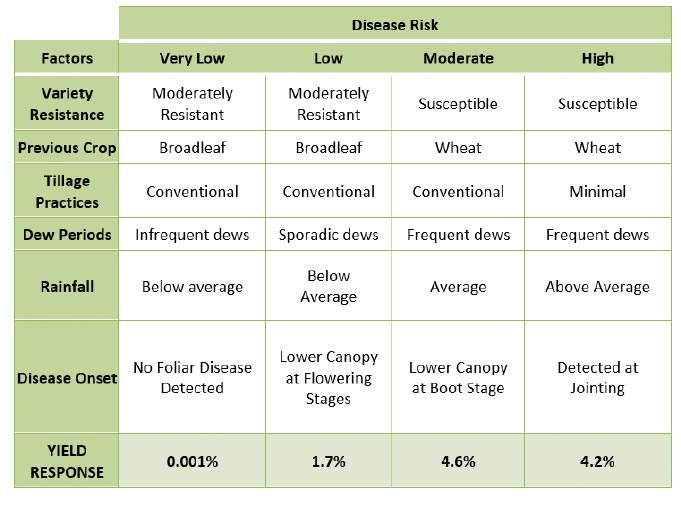
Copper Fertility in Small Grains
Copper is a nutrient that in most cases in ample supply in our soils and is an often overlooked micronutrient when setting up a crop nutrition plan, but I’m here to tell you that this is a nutrient to pay attention to. Small grains happen to be one of the most sensitive crops to a copper deficiency with spring wheat and durum being the most sensitive followed by barley, oats, and rye. Copper is responsible for multiple processes in wheat vegetative and reproductive growth. When deficient, plants become pale yellow, have wilted leaf tips, and are severely stunted. During the flowering stages of wheat, low copper concentrations can lead to florets staying open longer which can leave the plant more susceptible to diseases like ergot and Fusarium head blight. The best way to know if your spring wheat or durum may be responsive to a copper application starts with a soil test. The critical soil test level for copper is 0.5 ppm, if your soil falls below that level then it’s time to pay attention to the following parameters: soils with a pH above 7.5, organic matters below 3%, and coarse soil textures will have the least amount of copper available to the plant. If soil tests indicate that levels are below 0.5 ppm AND you have a pH above 7.5 with organic matter below 3% on a sand, you have the highest probability of a response from a copper application. So, let’s say you’ve decided that you want to add copper to your fertility program, what timing and what form of copper is best for application? Back in my days working for Winfield United, the Answer Plot program answered just this question. Foliar applications made at the tillering stage showed the greatest yield responses vs soil applied in the spring before planting. This means a copper source can be added to your in-crop herbicide application. Many copper products are available these days so make sure you talk with your Horizon Resources agronomist to determine which product and rate works best for your situation.
Kyle Okke, Crop Consultant